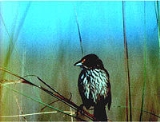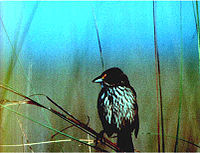
Cape Sable Seaside Sparrow
Encyclopedia
The Cape Sable Seaside Sparrow (Ammodramus maritimus mirabilis) is a sub-species of Seaside Sparrow
endemic to southern Florida
. The largest populations are found in Taylor Slough
in Everglade National Park and in the Big Cypress Swamp. The species is considered endangered
due to habitat loss from vegetation changes, fire, development, alteration of water flow, and hurricanes.
 Cape Sable Seaside Sparrows are about 13 centimeters (5 inches) long. The back is dark olive-gray and the tail and wings are olive-brown. Adults are light gray on the belly to almost white with dark olive-gray streaks on the breast and sides.
Cape Sable Seaside Sparrows are about 13 centimeters (5 inches) long. The back is dark olive-gray and the tail and wings are olive-brown. Adults are light gray on the belly to almost white with dark olive-gray streaks on the breast and sides.
The Cape Sable Seaside Sparrow lives on the prairies of the Everglades
and the Big Cypress Swamp. (Prairies are grasslands subject to frequent fires which limit the growth of trees. Dry prairies flood after heavy rains. Wet prairies are flooded from two to five months each year.) Specific habitats for the sparrows on the prairies are stands of muhly grass (Muhlenbergia
filipes), short sawgrass (Cladium
jamaicense), tall, clumped cordgrass, and relatively spares low cordgrass.
Seaside Sparrow
The Seaside Sparrow, Ammodramus maritimus, is a small American sparrow. The 11 Ammodramus species inhabit marshes and grasslands.Adults have brownish upperparts with grey on the crown and nape, and a grayish buff colored breast with dark streaks; they have a dark face with grey cheeks, a white...
endemic to southern Florida
Florida
Florida is a state in the southeastern United States, located on the nation's Atlantic and Gulf coasts. It is bordered to the west by the Gulf of Mexico, to the north by Alabama and Georgia and to the east by the Atlantic Ocean. With a population of 18,801,310 as measured by the 2010 census, it...
. The largest populations are found in Taylor Slough
Taylor Slough
Taylor Slough, located in the southeastern corner of the Florida Everglades, along with the much larger Shark River Slough farther to the west, are the principal natural drainages for the freshwater Everglades....
in Everglade National Park and in the Big Cypress Swamp. The species is considered endangered
Endangered species
An endangered species is a population of organisms which is at risk of becoming extinct because it is either few in numbers, or threatened by changing environmental or predation parameters...
due to habitat loss from vegetation changes, fire, development, alteration of water flow, and hurricanes.

The Cape Sable Seaside Sparrow lives on the prairies of the Everglades
Everglades
The Everglades are subtropical wetlands in the southern portion of the U.S. state of Florida, comprising the southern half of a large watershed. The system begins near Orlando with the Kissimmee River, which discharges into the vast but shallow Lake Okeechobee...
and the Big Cypress Swamp. (Prairies are grasslands subject to frequent fires which limit the growth of trees. Dry prairies flood after heavy rains. Wet prairies are flooded from two to five months each year.) Specific habitats for the sparrows on the prairies are stands of muhly grass (Muhlenbergia
Muhlenbergia
Muhlenbergia is a genus of grass in the Poaceae family. It is named in honour of the American amateur botanist Gotthilf Heinrich Ernst Muhlenberg. There are around 155 species. Many are known by the common name muhly....
filipes), short sawgrass (Cladium
Cladium
Cladium is a genus of large sedges, with a worldwide distribution in tropical and temperate regions...
jamaicense), tall, clumped cordgrass, and relatively spares low cordgrass.

